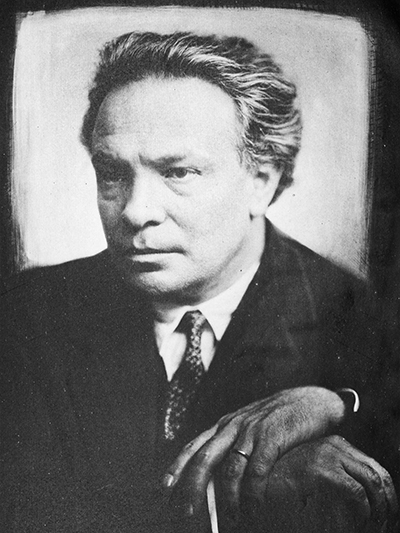Ottorino Respighi

Born: July 9, 1879, Bologna, Italy
Died: April 18, 1936, Rome, Italy
Fontane di Roma ("Fountains of Rome")
- Composed: 1916
- Premiere: March 11, 1917, Augusteo Orchestra, Rome, conducted by Antonio Guarnieri
- CSO Notable Performances:
- First: March 1924, Fritz Reiner conducting
- Most Recent: September 2012, Rafael Frühbeck de Burgos conducting
- Recording: Respighi: Pines of Rome, Fountains of Rome, Metamorphoseon Modi XII released in 2000, Jesús López Cobos conducting
- Instrumentation: 2 flutes, piccolo, 2 oboes, English horn, 2 clarinets, bass clarinet, 2 bassoons, 4 horns, 3 trumpets, 3 trombones, tuba, timpani, chime, crash cymbals, glockenspiel, suspended cymbals, triangle, 2 harps, celeste, piano, strings
- Duration: approx. 15 minutes
One of the foremost Italian composers of the early 20th century, Ottorino Respighi is best known for his trilogy of symphonic poems celebrating the city of Rome. Beginning with Fountains of Rome in 1916 and followed by Pines of Rome (1924) and Roman Festivals (1928), Respighi masterfully expressed Roman scenes in his colorful orchestral compositions.
As a child in Bologna, Respighi took violin lessons and taught himself how to play piano. He later enrolled in the Liceo Musicale di Bologna, where he continued studying violin, as well as viola, and began studies in composition and music history. In 1899, Respighi began playing violin for the Teatro Comunale di Bologna, and he spent the winters of 1900 and 1902 as a violist with the Russian Imperial Theatre in St. Petersburg. While in Russia, Respighi took lessons with the great composer Nikolai Rimsky-Korsakov, who had a profound impact on Respighi’s approach to orchestration. Respighi would also later draw on inspiration from other composers, including Gustav Mahler and Richard Strauss, in the ways he combined orchestral instruments to create rich timbres and employed sounds in expressive programmatic compositions.
Orchestral music had, by the first decades of the 20th century, experienced a revival in Italy, after a 19th century when musical taste and national spirit was focused on opera, and Rome became Italy’s most active city for orchestral music-making. Large orchestral ensembles were still a novelty at the time, and Respighi delighted in the colorful kaleidoscopic sounds the instruments of the orchestra could produce.
In 1913, Respighi moved to Rome, where he became professor of composition at the Liceo Musicale di Santa Cecilia. As he settled into his new post, he devoted his energies to purely orchestral music, beginning with his large-scale Sinfonia drammatica. He was soon inspired by the fountains of the city, perceiving their bubbling waters as the voice of Rome, and he wanted to make them sing in his music.
In four continuous movements, Respighi’s Fountains of Rome takes the audience on a tour of the city’s most famous fountains, musically depicting each site at the time of day it would appear most beautiful. This expressive approach has the effect of a plein air portrait, transporting the listeners to specific times and places to immerse them in meaningful experiences. In the preface of his score, Respighi included a detailed program poetically describing each scene he depicted in his music:
In this symphonic poem, the composer has endeavored to give expression to the sentiments and visions suggested to him by four of Rome’s fountains, contemplated at the hour in which their character is most in harmony with the surrounding landscape, or in which their beauty appears most impressive to the observer.
The first part of the poem, inspired by the Fountain of Valle Giulia, depicts a pastoral landscape. Droves of cattle pass and disappear in the fresh, damp mists of a Roman dawn.
A sudden loud and insistent blast of horns above the whole orchestra introduces the second part, “The Triton Fountain.” It is like a joyous call, summoning troops of naiads and tritons, who come running up pursuing each other and mingling in a frenzied dance between the jets of water.
Next there appears a solemn theme, borne on the undulations of the orchestra. It is the Fountain of Trevi at midday. The solemn theme, passing from the wood to the brass instruments, assumes a triumphal character. Trumpets peal; across the radiant surface of the water there passes Neptune’s chariot, drawn by sea-horses and followed by a train of sirens and tritons. The procession then vanishes, while faint trumpet blasts resound in the distance.
The fourth part, “The Villa Medici Fountain,” is announced by a sad theme which rises above a subdued warbling. It is the nostalgic hour of sunset. The air is full of the sound of tolling bells, birds twittering, leaves rustling. Then all dies peacefully into the silence of the night.”
While Respighi’s Fountains of Rome is now regarded among his most successful compositions, the piece had a shaky start with its first planned performance. Conductor Arturo Toscanini was scheduled to conduct the premiere in March 1917. However, he presented the funeral march of Götterdämmerung earlier in the program and the audience responded to Wagner’s music with hostility. After alienating the audience, Toscanini refused to continue the performance. The conductor Antonio Guarnieri later stepped in to conduct Respighi’s Fountains of Rome, but the audience’s lingering bitterness ultimately tainted their reaction to the piece. Respighi feared the poor reception was a sign of his failure but, in February 1918, Toscanini conducted the piece at La Scala to great success. The piece has achieved renown since this redemptive performance, receiving performances around the world over the past century and becoming Respighi’s most well-known composition.
—Dr. Rebecca Schreiber